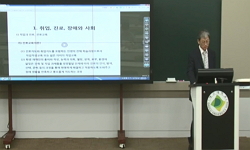This study aims to analyze recent changes and limitations in the Korean judiciary regarding the protection of access to justice for persons with disabilities and to propose future improvements. In recent years, the Supreme Court has issued a series of...
http://chineseinput.net/에서 pinyin(병음)방식으로 중국어를 변환할 수 있습니다.
변환된 중국어를 복사하여 사용하시면 됩니다.
- 中文 을 입력하시려면 zhongwen을 입력하시고 space를누르시면됩니다.
- 北京 을 입력하시려면 beijing을 입력하시고 space를 누르시면 됩니다.
부가정보
다국어 초록 (Multilingual Abstract)
This study examines (1) the legal basis of access to justice for persons with disabilities, (2) the need for judicial support based on disability type, and (3) the factors that restrict access to justice for persons with disabilities. It then (4) analyzes the contents of court guidelines, compares them with international standards, and (5) proposes legislative and institutional improvements. The findings indicate that the court guidelines are more focused on criminal proceedings than civil litigation and lack legal binding force, limiting their effectiveness. Furthermore, the existing guardianship system and legal capacity doctrine, which are designed to protect rather than recognize the abilities of persons with disabilities, serve as major obstacles to the realization of their legal rights.
To ensure meaningful access to justice for persons with disabilities, it is necessary to supplement the court guidelines and establish legally binding procedural regulations. Additionally, expanding augmentative and alternative communication (AAC) and interpretation services to facilitate communication between persons with disabilities and their legal representatives, as well as reforming the guardianship system to better acknowledge their legal capacities, are essential. This study emphasizes that such improvements are crucial for guaranteeing the substantive access to justice for persons with disabilities and aims to provide a foundation for future legislative and institutional developments.
This study aims to analyze recent changes and limitations in the Korean judiciary regarding the protection of access to justice for persons with disabilities and to propose future improvements. In recent years, the Supreme Court has issued a series of rulings recognizing the rights of persons with disabilities under the Anti-Discrimination and Remedies for Persons with Disabilities Act. Additionally, the judiciary has introduced various measures to strengthen judicial support for persons with disabilities, such as the establishment of new court regulations, the adoption of a next-generation electronic litigation system certified for accessibility, and the operation of court interpretation centers. Nevertheless, the reality remains that persons with disabilities continue to face significant barriers to accessing justice as litigants. The remarkably low number of lawsuits filed under the Anti-Discrimination Act and the ongoing concerns raised by the UN Committee on the Rights of Persons with Disabilities highlight the limitations of the current system.
This study examines (1) the legal basis of access to justice for persons with disabilities, (2) the need for judicial support based on disability type, and (3) the factors that restrict access to justice for persons with disabilities. It then (4) analyzes the contents of court guidelines, compares them with international standards, and (5) proposes legislative and institutional improvements. The findings indicate that the court guidelines are more focused on criminal proceedings than civil litigation and lack legal binding force, limiting their effectiveness. Furthermore, the existing guardianship system and legal capacity doctrine, which are designed to protect rather than recognize the abilities of persons with disabilities, serve as major obstacles to the realization of their legal rights.
To ensure meaningful access to justice for persons with disabilities, it is necessary to supplement the court guidelines and establish legally binding procedural regulations. Additionally, expanding augmentative and alternative communication (AAC) and interpretation services to facilitate communication between persons with disabilities and their legal representatives, as well as reforming the guardianship system to better acknowledge their legal capacities, are essential. This study emphasizes that such improvements are crucial for guaranteeing the substantive access to justice for persons with disabilities and aims to provide a foundation for future legislative and institutional developments.
동일학술지(권/호) 다른 논문
-
상속재산파산의 쟁점과 활성화 방안 - 신청단계를 중심으로 -
- 법조협회
- 이민령
- 2025
- KCI우수등재
-
구속 전 피의자심문의 제도적 의미와 기일 속행의 적법 여부 - 대법원 2025. 3. 13. 선고 2022도9819 판결 -
- 법조협회
- 이종수
- 2025
- KCI우수등재
-
- 법조협회
- 김지훈
- 2025
- KCI우수등재
-
신생 매립지 관할결정에 대하여 지방자치단체가 제기할 수 있는 헌법재판상의 불복수단에 대한 고찰
- 법조협회
- 김소연
- 2025
- KCI우수등재





 KCI
KCI KISS
KISS







